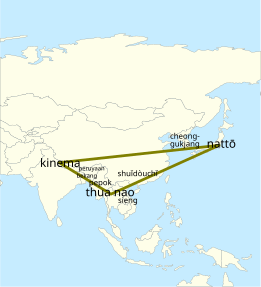Kinema
[4] According to microbiologist Jyoti Prakash Tamang, kinema is estimated to have originated around 600 BC to 100 AD during Kirat dynasty rule, introduced by Limbu people.
Kinema is considered a healthy food because fermentation breaks down complex proteins into easily digestible amino acids.
[10] Many other Asian countries have Bacillus-fermented soyabean dishes, such as shuǐdòuchǐ of China, cheonggukjang of Korea, nattō of Japan, thua nao of Thailand, tungrymbai of Meghalaya, hawaijaar of Manipur, bekangum of Mizoram, akhuni of Nagaland, and piak of Arunachal Pradesh, India.
Jyoti Prakash Tamang proposed a extended ‘KNT (Kinema-Natto-Thua Nao) triangle', connecting the fermented soyabeans across Asia.
[12] Jyoti Prakash Tamang shows evidence that fermented soybean styles in India all derive from kinema.
